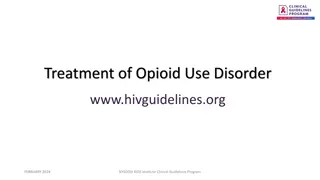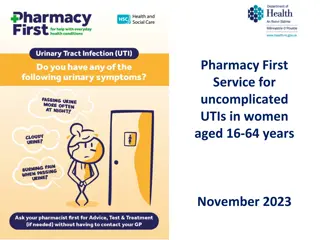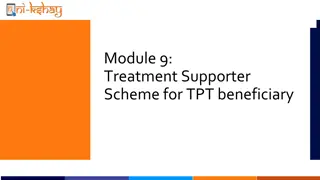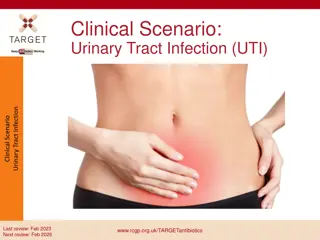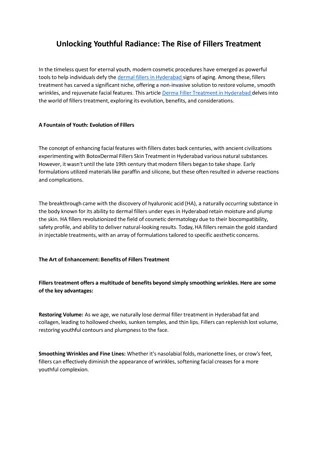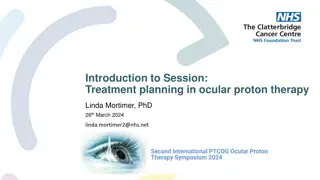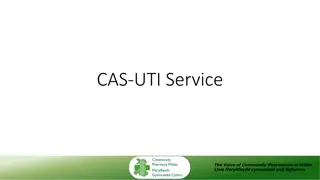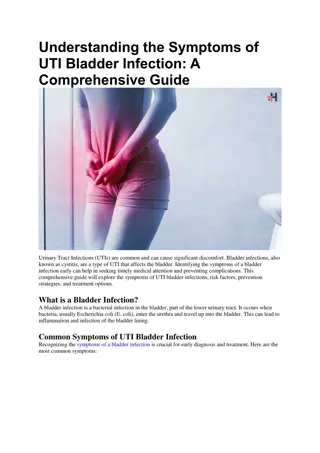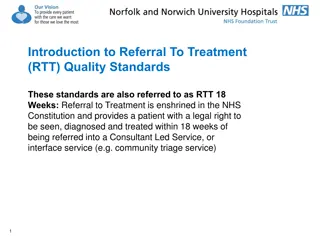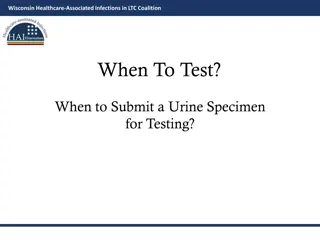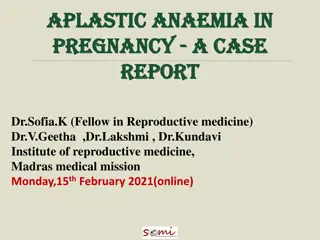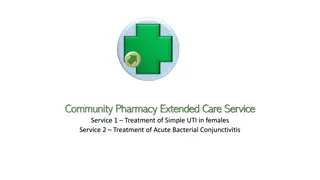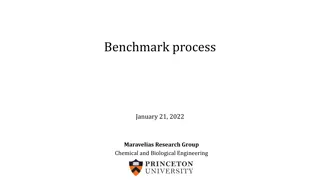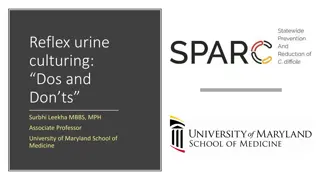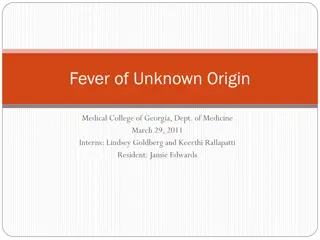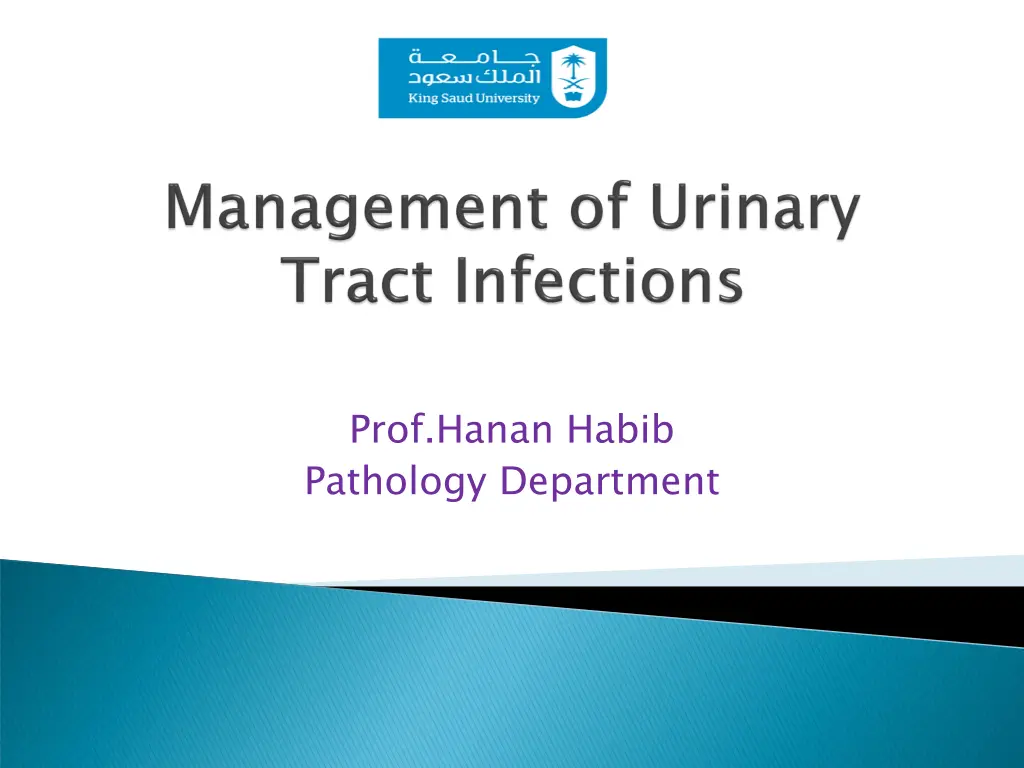
Management and Treatment of Urinary Tract Infection (UTI) - Prof. Hanan Habib Pathology Department
Understanding the principal goal of managing UTI, which involves eradicating the offending organisms using antibiotics. Factors influencing UTI management include infection complexity, recurrence, patient type, bacterial count, and symptoms. Treatment varies based on risk factors and may involve antibiotics like Amoxicillin, Cephalosporins, Fluoroquinolones, TMP-SMX, and Nitrofurantoin. Recurrent UTIs in low-risk patients can be addressed with a 3-day antibiotic course. Structural abnormalities or treatment failure may lead to more prolonged antibiotic regimens. Preventive therapy is recommended for patients experiencing frequent symptomatic UTIs.
Download Presentation

Please find below an Image/Link to download the presentation.
The content on the website is provided AS IS for your information and personal use only. It may not be sold, licensed, or shared on other websites without obtaining consent from the author. If you encounter any issues during the download, it is possible that the publisher has removed the file from their server.
You are allowed to download the files provided on this website for personal or commercial use, subject to the condition that they are used lawfully. All files are the property of their respective owners.
The content on the website is provided AS IS for your information and personal use only. It may not be sold, licensed, or shared on other websites without obtaining consent from the author.
E N D
Presentation Transcript
Prof.Hanan Habib Pathology Department
1- Recall the principal goal of management of urinary tract infection (UTI) and that antibiotics are the main treatment of UTI 2- Discuss the factors that management of UTI depends on 3- Describe the management/treatment of different conditions of UTI ( cystitis, pyelonephritis, catheter associated UTI ,etc.)
The principal goal of management of UTI is to eradicate the offending organisms from the urinary bladder and tissues. The main treatment of UTI is by antibiotics.
Whether infection is complicated or uncomplicated. Whether infection is primary or recurrent. Type of patient (pregnant ,child , hospitalized or not, diabetic patient, ..etc) Bacterial count. Presence of symptoms.
Low-risk patient (woman) for recurrent infection: 3 days antibiotic without urine test. Cure rate 94%. Choice of antibiotic depend on susceptibility pattern of bacteria, it includes ; Amoxicillin ( with or without clavulanic acid) Cephlosporins ( first or second generation)
Fluoroquinolone ( ciprofloxacin or norfloxacin) (not for pregnant women or children under 18 year) ,first choice if other antibiotics are resistant. TMP-SMX ( trade names: Bactrim, Septra ,Cotrimoxazole) Nitrofurantoin ( for long term use)
Caused by treatment failure or structural abnormalities or abscesses. Caused by treatment failure or structural abnormalities or abscesses. Antibiotics used at the initial infection Antibiotics used at the initial infection Treatment for 7 Treatment for 7- -14 days. 14 days.
Patients with two or more symptomatic UTIs within 6 months or 3 or more over a year. Need preventive therapy Antibiotic taken as soon as symptoms develop. Need preventive therapy If infection occurs less than twice a year, a clean catch urine test culture days. clean catch urine test should be taken for culture and treated as initial attack for 3 should be taken for
If symptoms persist A change in symptoms Pregnant women More than 4 infections per year Impaired immune system Previous kidney infections Structural abnormalities of urinary tract History of infection with antibiotic resistant bacteria. If symptoms persist A change in symptoms Pregnant women More than 4 infections per year Impaired immune system Previous kidney infections Structural abnormalities of urinary tract History of infection with antibiotic resistant bacteria.
If recurrent UTI is related to sexual activity, and episodes recur more than 2 times within 6 months A single preventive dose taken immediately after intercourse Antibiotics include: TMP-SMX, Cephalexin or Ciprofloxacin
Optional for patients who do not respond to other measures. Reduces recurrence by up to 95% Low dose antibiotic taken continuously for 6 months or longer, it includes : TMP-SMX, Nitrofurantoin, or Cephalexin Antibiotic taken at bed time more effective. Low dose antibiotic taken continuously for 6 months or longer, it includes :
Patients with fever, chills and flank pain but they are healthy, non-pregnant, female, without relevant comorbidities and without structural or functional urinary tract abnormalities Can be treated at home with oral antibiotics for 14 days with one of the followings: Cephalosporins, Amoxicillin-Clavulanic acid, Ciprofloxacin or TMP-SMX. First dose may be given by injection
Patients need Antibiotic given by IV route symptoms relieved for 24-48 hrs. If fever and back pain continue after 72 hrs of antibiotic, , imaging tests abscesses, obstruction or other abnormality. Patients need hospitalization hospitalization IV route for 3-5 days until imaging tests indicated to exclude
Those patients need long-term antibiotic treatment even during periods when they have no symptoms. Go to fullsize image Go to fullsize image
Pregnant women High risk for UTI and complications Should be screened for UTI Antibiotics during pregnancy includes;; Amoxicillin, Ampicillin, Cephalosporins, and Nitrofurantoin. Pregnant women should NOT take Quinolones. Pregnant women
Pregnant women with asymptomatic bacteriuria ( evidence of infection but no symptoms) have 30% risk for acute pyelonephritis in the second or third trimester. Screening and 7-10 days antibiotic needed. For uncomplicated UTI (any patient , not at pregnancy ) need 3-5 days antibiotic treatment.
Have more frequent and more sever UTIs. Treated for 7-14 days with antibiotics even patients with uncomplicated infections.
Most important causes: Neisseria gonorrheae Chlamydia trachomatis Treated with IM Ceftriaxone Azithromycin IM Ceftriaxone + Doxycycline or Azithromycin. . Doxycycline or Patients should also be tested for accompanying STD.
Usually treated with TMP-SMX or Cephalexin. Sometimes given as IV . Gentamicin may be recommended as resistance to Cephalexin is increasing.
Common in children with UTI Can lead to pyelonephritis and kidney damage. Long-term antibiotic plus correct VUR and prevent infections. Acute kidney infection : use Cefixime ( oral) or IV Ceftriaxone or Gentamicin dose for 2-4 days followed by oral treatment eg. amoxicillin-clavulanic acid or TMP-SMX . plus surgery used to Gentamicin a one daily
Go to fullsize image Go to fullsize image
Very common Preventive measures important Catheter should not be used unless absolutely necessary and they should be removed as soon as possible. Go to fullsize image
If catheter is required for long periods ,it is best to be used intermittently. May be replaced every 2 weeks to reduce risk of infection and irrigating bladder with antibiotics between replacements Daily hygiene and use of closed system to prevent infection. Daily hygiene and use of closed system to prevent infection.
Catheterized patients who develop UTI with symptoms or at risk for sepsis should be treated for each episode with antibiotics and catheter should be removed, if possible. Associated organisms are constantly changing. May be multiple species of bacteria.
Antibiotic use for prophylaxis is rarely recommended since high bacterial counts present and patients do not develop symptomatic UTI. ANTIBIOTIC THERAPY HAS LITTLE BENEFIT IF THE CATHETER IS TO REMAIN IN PLACE FOR LONG PERIOD.

